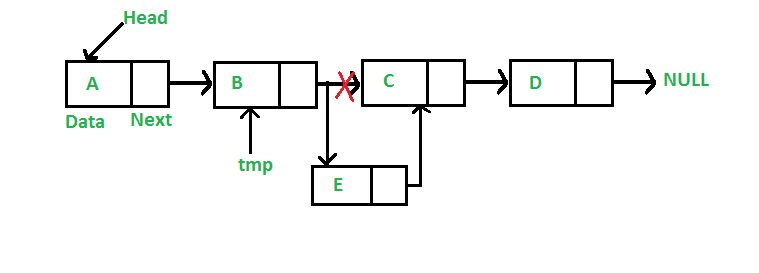Python Program For Inserting A Node In A Linked List
Last Updated :
05 Sep, 2022
We have introduced Linked Lists in the previous post. We also created a simple linked list with 3 nodes and discussed linked list traversal.
All programs discussed in this post consider the following representations of linked list.
Python
class Node:
def __init__(self, data):
self.data = data
self.next = None
class LinkedList:
def __init__(self):
self.head = None
|
In this post, methods to insert a new node in linked list are discussed. A node can be added in three ways
1) At the front of the linked list
2) After a given node.
3) At the end of the linked list.
Add a node at the front: (4 steps process)
The new node is always added before the head of the given Linked List. And newly added node becomes the new head of the Linked List. For example, if the given Linked List is 10->15->20->25 and we add an item 5 at the front, then the Linked List becomes 5->10->15->20->25. Let us call the function that adds at the front of the list is push(). The push() must receive a pointer to the head pointer, because push must change the head pointer to point to the new node (See this)

Following are the 4 steps to add a node at the front.
Python
def push(self, new_data):
new_node = Node(new_data)
new_node.next = self.head
self.head = new_node
|
Time complexity of push() is O(1) as it does a constant amount of work.
Add a node after a given node: (5 steps process)
We are given a pointer to a node, and the new node is inserted after the given node.

Python
def insertAfter(self, prev_node, new_data):
if prev_node is None:
print "The given previous node must in LinkedList."
return
new_node = Node(new_data)
new_node.next = prev_node.next
prev_node.next = new_node
|
Time complexity of insertAfter() is O(1) as it does a constant amount of work.
Add a node at the end: (6 steps process)
The new node is always added after the last node of the given Linked List. For example if the given Linked List is 5->10->15->20->25 and we add an item 30 at the end, then the Linked List becomes 5->10->15->20->25->30.
Since a Linked List is typically represented by the head of it, we have to traverse the list till the end and then change the next to last node to a new node.

Following are the 6 steps to add node at the end.
Python
def append(self, new_data):
new_node = Node(new_data)
if self.head is None:
self.head = new_node
return
last = self.head
while (last.next):
last = last.next
last.next = new_node
|
Time complexity of append is O(n) where n is the number of nodes in the linked list. Since there is a loop from head to end, the function does O(n) work.
This method can also be optimized to work in O(1) by keeping an extra pointer to the tail of the linked list/
Following is a complete program that uses all of the above methods to create a linked list.
Python
class Node:
def __init__(self, data):
self.data = data
self.next = None
class LinkedList:
def __init__(self):
self.head = None
def push(self, new_data):
new_node = Node(new_data)
new_node.next = self.head
self.head = new_node
def insertAfter(self, prev_node, new_data):
if prev_node is None:
print "The given previous node must inLinkedList."
return
new_node = Node(new_data)
new_node.next = prev_node.next
prev_node.next = new_node
def append(self, new_data):
new_node = Node(new_data)
if self.head is None:
self.head = new_node
return
last = self.head
while (last.next):
last = last.next
last.next = new_node
def printList(self):
temp = self.head
while (temp):
print temp.data,
temp = temp.next
if __name__=='__main__':
llist = LinkedList()
becomes 6->None
llist.append(6)
llist.push(7);
llist.push(1);
llist.append(4)
llist.insertAfter(llist.head.next, 8)
print 'Created linked list is:',
llist.printList()
|
Output:
Created Linked list is: 1 7 8 6 4
Time complexity: O(N) where N is size of given linked list
Auxiliary space: O(1), it is not taking extra space
Please refer complete article on Linked List | Set 2 (Inserting a node) for more details!
Like Article
Suggest improvement
Share your thoughts in the comments
Please Login to comment...